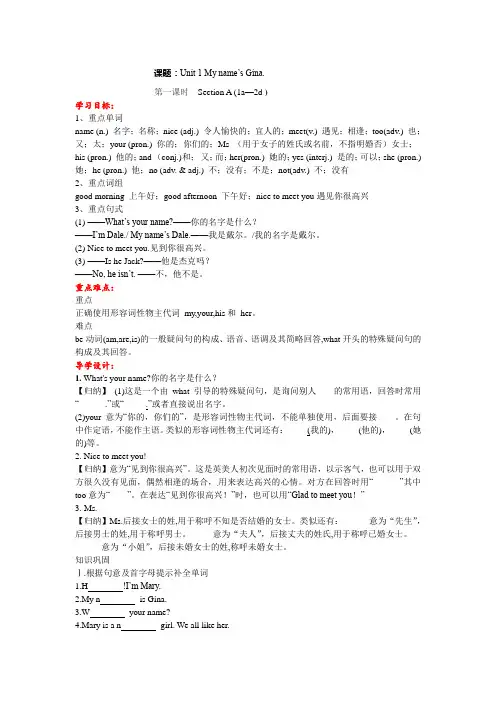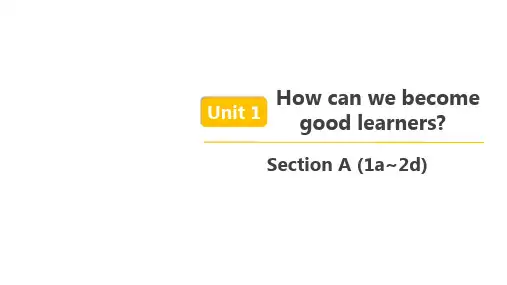Unit1 sectiona 1a-2d
- 格式:doc
- 大小:34.50 KB
- 文档页数:2

课题:Unit 1 My name’s Gina.第一课时Section A (1a—2d )学习目标:1、重点单词name (n.) 名字;名称;nice (adj.) 令人愉快的;宜人的;meet(v.) 遇见;相逢;too(adv.) 也;又;太;your (pron.) 你的;你们的;Ms (用于女子的姓氏或名前,不指明婚否)女士;his (pron.) 他的;and (conj.)和;又;而;her(pron.) 她的;yes (interj.) 是的;可以;she (pron.) 她;he (pron.) 他;no (adv. & adj.) 不;没有;不是;not(adv.) 不;没有2、重点词组good morning 上午好;good afternoon 下午好;nice to meet you遇见你很高兴3、重点句式(1)——What’s your name?——你的名字是什么?——I’m Dale./ My name’s Dale.——我是戴尔。
/我的名字是戴尔。
(2)Nice to meet you.见到你很高兴。
(3)——Is he Jack?——他是杰克吗?——No, he isn’t. ——不,他不是。
重点难点:重点正确使用形容词性物主代词my,your,his和her。
难点be动词(am,are,is)的一般疑问句的构成、语音、语调及其简略回答,what开头的特殊疑问句的构成及其回答。
导学设计:1. What's your name?你的名字是什么?【归纳】(1)这是一个由what引导的特殊疑问句,是询问别人____的常用语,回答时常用“______.”或“_____.”或者直接说出名字。
(2)your意为“你的,你们的”,是形容词性物主代词,不能单独使用,后面要接____。
在句中作定语,不能作主语。
类似的形容词性物主代词还有:_____(我的),_____(他的),_____(她的)等。

Unit 1 Section A 1a2d教学目标:1、Knowledge aim: Students can learn some new words and expressions from thegiven material and students can get the main idea of the material. .2、Ability aim: Students can learn how to talk about this topic and how to expresstheir own ideas with these new expressions.教学重难点:重点:Teaching key point: Students can improve their speaking skills.难点:Teaching difficult point: Students can talk this topic in their daily life.教学过程:Do you do these chores at home?Discuss them with your partner.1. do the dishes2. take out the rubbish3.fold your clothes4. sweep the floor5.make the bed6. clean the living roomModelA: What do you do at home?B: I …SkimmingThis means looking quickly through a piece of writing to find the main idea without reading every word. It is still a good idea to read the first sentence in each paragraph a little more carefully.They are probably about whether kids should________.A. spend time on schoolworkB. help out with chores at homeC. learn to be independent(独立的)Dear Sir,I do not understand why some parents make their kids help with housework and chores at home. Kids these days already have enough stress from school.They do not have time to study and do housework, too. Housework is a waste of their time. Could we just let them do their job as students? They should spend their time on schoolwork in order to get good grades and get into a good university. Also, when they get older, they will have to do housework so there is no need for them to doit now. It is the parents’job to provide a clean and fortable environment at home for their children. And anyway, I think doing chores is not so difficult. I do not mind doing them.Ms. MillerDear Sir,I think it is important for children to learn how to do chores and helptheir parents with housework. It is not enough to just get good grades at school. Children these days depend on their parents too much. They are always asking, “Could you get this for me?”or “Could you help me with that?”Doing chores helps to develop children's independence and teaches them how to look after themselves. Italso helps them to understand the idea of fairness. Since they live in one house with their parents, they should know that everyone should do their part in keeping it clean and tidy. Our neighbors’son got into a good college but during his first year, he had no idea how to take care of himself. As a result, he often fell ill and his grades dropped. The earlier kids learn to be independent, the better it is for their future.Mr. SmithMake conversations between Peter and his father.Ask for permission礼貌地取得同意A: Could I use your puter?B: Sorry. I'm going to work on it now.A: Well, could I watch TV?B: Yes, you can, but first you have to clean your room.homework.Help your parents do housework..Make a new conversation about housework.DiscussionQ1: Do you help your parents do the chores at home?Q2: Do you ask your parents’permission for?Q3: Do your parents ask you to do some things for them? What do your parents ask you to do?study harddo choresgo to the store/supermarket to buy things for them。









Unit1 Period1教案
Section A (1a-2d)
教学过程
Warming-up and revision
找出三名外貌差异较大的学生来做比较,一个胖而高大的男生(a fat and tall boy),一个瘦而较矮的男生(a thin and short boy),一个中等身材(of medium height)。
然后用这两名学生为例教heavy, tall, thin, short引出句型:
1. What do you look like? He’s really tall. He has long straight hair.
2. What does she look like? Sh e’s of medium/build.
…
Presentation (Section A 1a)
1. Match the words with the people in the picture. (1a)
2. 引导学生熟悉有关描述人的外貌特征的词
Practice (Section A 1c)
1. Read the conversation and recite it.
2. Practice like the conversation according to some pictures.
Listening (1b, 2a & 2b)
1. Look at the picture of 1a, listen and fill the blanks in the picture. (1b)
Listen carefully and fill in the blanks and find Amy’s friend? We will listen twice.The first time, just listen.The second time,listen and fill in the blanks.And say the look of Amy’s friend.( He's really tall.And he has curly hair.)
2. Listen and answer the questions. (2a)
3. Listen again and fill in the chart. (2b)
4. Listen a third time to understand the key words.
Practice (2c)
1. Student A looks at the chart in 2b. Student B asks Student A questions about one of the people and then draws a picture of the person quickly.
2. Act the dialogue.
Role-play the conversation. (2d)
1. Read the conversation to answer the questions:
(1)When are they meeting?
(2)Where are they meeting?
(3)What does David look like?
(4) Is he tall or short?
2. Read the conversation.
3.Role-play the conversation.
4. Explanation:
(1) may be
(2) a little
Homework
1. 熟记本节课所学单词。
2.Describe your friends in the class and draw a picture of them.。